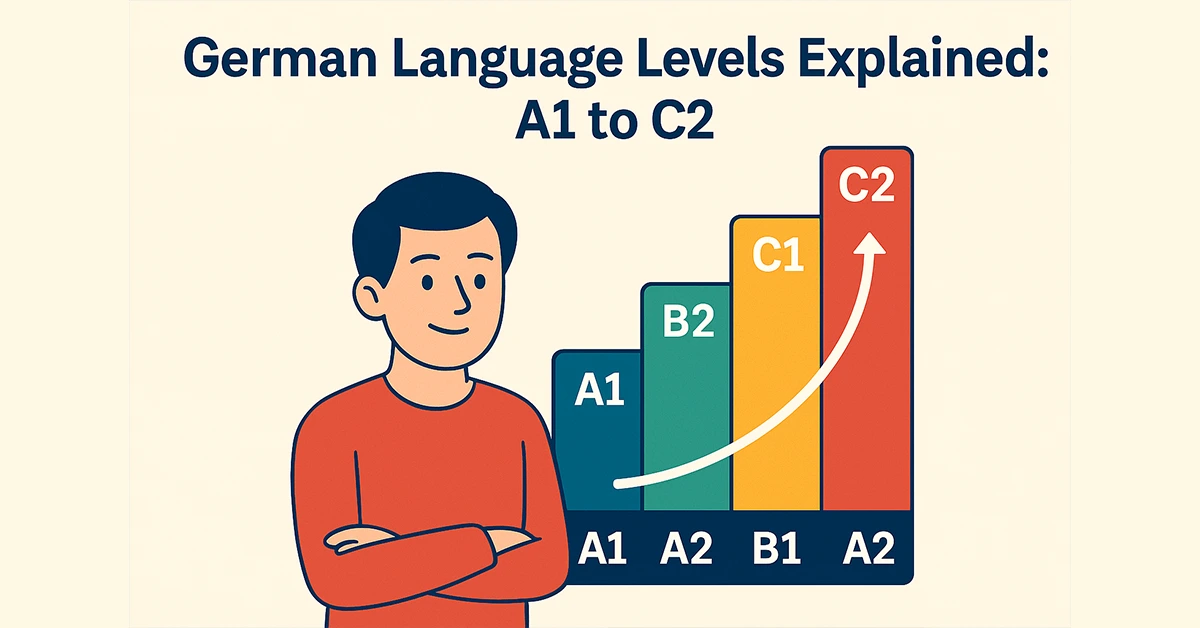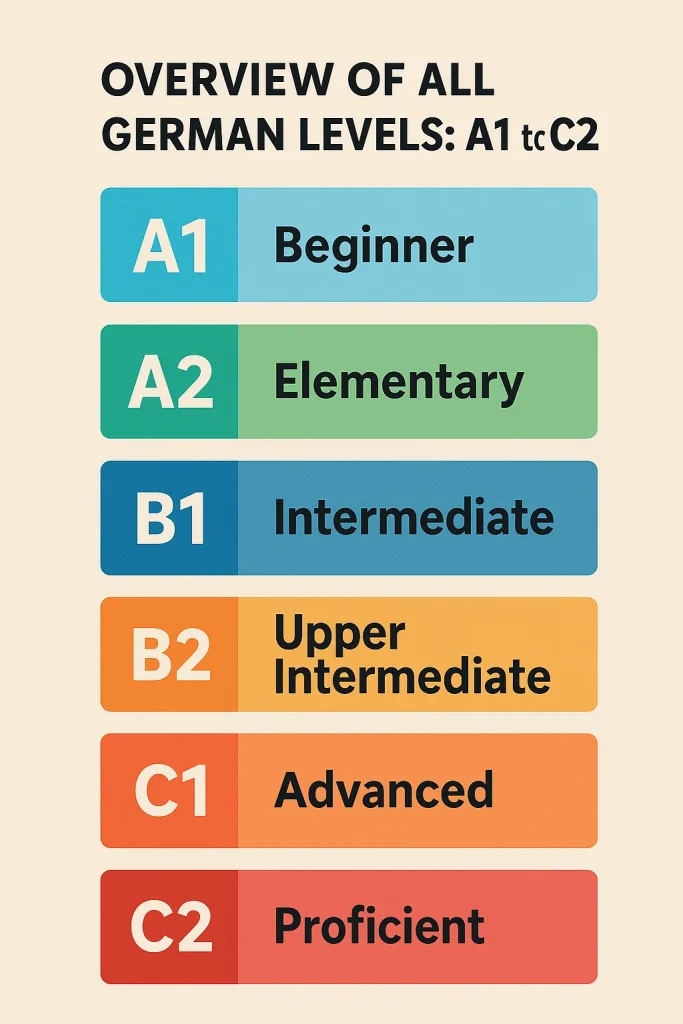German Language Levels Explained: A1 to C2 in Simple Terms

Understand the official CEFR language levels from A1 to C2.
Learn what each German level means, what skills you can expect to master, and how to progress efficiently on your language learning journey.
What Are the CEFR Levels in German?
The Common European Framework of Reference for Languages (CEFR) is an international standard used to measure language proficiency. It divides learners into six levels: A1, A2, B1, B2, C1, and C2.
These levels describe what you can do in reading, writing, listening, and speaking. Whether you’re learning German or any other language, the CEFR levels help you track your progress and set clear learning goals.
- A1 (Beginner): Understand and use very basic expressions and phrases.
- A2 (Elementary): Communicate simple tasks and routine matters.
- B1 (Intermediate): Deal with everyday situations and express opinions.
- B2 (Upper Intermediate): Interact with a degree of fluency and spontaneity.
- C1 (Advanced): Use the language effectively for academic and professional purposes.
- C2 (Proficient): Understand almost everything and express yourself effortlessly.
If you’re learning German, knowing your CEFR level can help you choose the right materials, courses, and certification exams.
Why Knowing Your Level Matters
Understanding your level helps you find the right learning materials, set realistic goals, and apply for jobs or courses that match your ability. Language certificates are also based on these levels.
Overview of All German Levels: A1 to C2

A1 Level – Absolute Beginner
This level is for people just starting to learn German. You’ll learn basic greetings, introductions, numbers, days of the week, and simple sentence structures.
Skills You Gain at A1 German
- Introducing yourself and others
- Understanding and using common phrases
- Asking and answering basic questions
- Reading short texts and signs
A2 Level – Elementary Understanding
At A2, you expand your vocabulary and can talk about daily routines, family, shopping, and work in simple terms.
What You Can Do at A2 German
- Describe your background, education, and immediate environment
- Understand phrases related to personal and family information
- Write short notes and simple messages
B1 Level – Intermediate Fluency Starts
B1 is a turning point: you can now handle most situations while traveling, describe experiences, and express opinions.
What You Should Master at B1
- Understanding the main points in everyday conversations
- Writing short essays and letters
- Dealing with situations at work, school, or during travel
B2 Level – Upper Intermediate Communication
At B2, you gain more confidence with abstract topics and argumentation. You can understand native speakers more easily.
Real-World Tasks You Handle at B2
- Participate in meetings and discussions
- Read news articles, reports, and opinion pieces
- Write detailed texts and essays
C1 Level – Advanced German User
This level is often required for studying at a German university or working in a professional environment in Germany.
Academic and Work Use at C1
- Write academic texts and reports
- Understand long, complex speech and texts
- Use language fluently and spontaneously
C2 Level – Near Native Proficiency
C2 is the highest level, demonstrating full mastery of the language. You understand and produce complex texts, idiomatic expressions, and cultural nuances.
Is C2 Level Necessary?
C2 is useful for translators, language teachers, or anyone aiming for native-level fluency. However, for most learners, C1 is more than sufficient for work and academic life.
German Exam Certifications for Each Level
- A1–B1: Goethe-Zertifikat A1, A2, B1
- B2–C2: Goethe-Zertifikat B2, C1, C2
- Also available: TELC, ÖSD, TestDaF (B2–C1), DSH (C1)
How Long It Takes to Reach Each Level
| Level | Average Hours of Study |
|---|---|
| A1 | 60–100 hours |
| A2 | 150–200 hours |
| B1 | 300–350 hours |
| B2 | 500–600 hours |
| C1 | 700–800 hours |
| C2 | 1000+ hours |
Tips to Progress from A1 to C2 Faster
- Set a regular study schedule
- Use immersive methods: TV, music, books
- Practice speaking with native speakers
- Take mock exams for each level
Common Mistakes When Assessing Your Level
- Overestimating fluency after reaching B1
- Ignoring writing and listening skills
- Focusing only on vocabulary without grammar
Conclusion: Set Goals Based on Your German Level
Understanding CEFR levels helps you navigate your German learning journey with clarity. Identify your current level, set your next goal, and stay consistent to reach fluency.
Frequently Asked Questions About German Language Levels
What does A1, A2, B1, B2, C1, and C2 mean in German learning?
These are CEFR levels that show your German proficiency—from beginner (A1) to mastery (C2). Each level reflects your ability in reading, listening, speaking, and writing.
What level of German do I need to work in Germany?
For most jobs, B1 or B2 is enough. For academic or professional roles, C1 is often required. Medical and legal jobs may need C1–C2.
How long does it take to reach B1 or B2?
With regular study, it takes about 6–9 months to reach B1, and 1–1.5 years to reach B2, depending on intensity and consistency.
Which German exams match the CEFR levels?
The Goethe-Zertifikat exams (A1–C2), TELC, ÖSD, TestDaF (B2–C1), and DSH (C1) are commonly used and CEFR-aligned.
Is it necessary to reach C2 in German?
Not for most learners. C1 is sufficient for work or study. C2 is mainly needed for translators, teachers, or those aiming for native-like fluency.